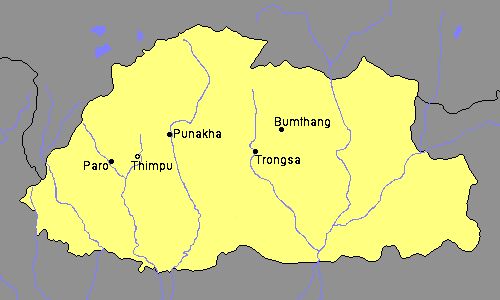
About the country: Also know as Druk Yul (The Land of the Dragon), Bhutan is a country about the size of Switzerland located on the southern portion of the Himalayan mountain range. It can be found on a map by first locating Bangladesh (toward the east of India), then continuing north through the Indian panhandle until you reach Bhutan. It is surrounded by India and the Tibetan region of China.
Few people visit Bhutan, only 15,000-16,000 people in 2005, 13,900 of which were tourists and the remainder being government officials and guests of residents of Bhutan. There are also many Indian immigrants who work on building and road construction projects.
The daily tourist fee is currently $200 per person. Fortunately, we entered the country as guests of the Minister of Labor and Human Resources, Ugyen Thering, and his wife, Patrizia Franceschinis, friends of the family, so we weren't required to pay the tourist fee.
Bhutan is currently a monarchy, but the king is abdicating most of his political powers as the government changes to a democracy in 2008. The current government operates under a philosophy of raising GNH, rather than just concentrating on raising the GDP. GNH, Gross National Happiness, is a concept formulated by the king and is based on the premise that all citizens want to increase their individual happiness, and therefore it should be the duty of any government of the people to assist them in achieving that goal.

Arrival: After spending the night in the Bangkok airport, we boarded our early morning flight bound for Bhutan. After a short layover in Kolkata (Calcutta), India, we touched down in the city of Paro. The weather was overcast and rainy, but the pilot was able to weave the Airbus A319 through the mountaintops and land safely at Bhutan's only international airport. Druk Air, Royal Bhutan Airlines, is the only airline to fly into Bhutan. They have two planes covering the Bangkok-Kolkata-Paro and Delhi-Kathmandu-Paro routes.
The road between Paro and Thimpu, the capital city where we stayed for the majority of the trip, is being widened and is therefore closed most of the day, opening intermittently to allow traffic to pass, turning a normally 1 ½-hour trip into 2 ½ hours, so Peep and I took the opportunity to see the city of Paro before leaving for Thimpu in the evening, after the roads open.
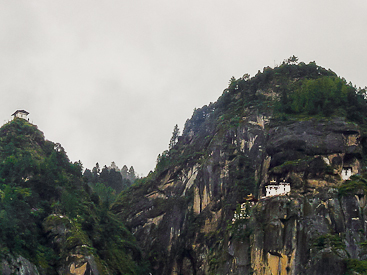
Taksang Monastery: Our first stop was to view Taktsang monastery nestled in the cliffs surrounding the Paro valley. This monastery is located near the cave where Guru Rinpoche meditated after arriving on a flying tigress, bringing Buddhism to the Paro valley. The hike to the monastery takes several hours, so we were content just admiring it from the valley. Apart from monasteries, there are also many isolation huts located throughout the mountainside. Monks use these for retreats, staying a total of 3 years, 3 months, 3 days and 3 hours at a time, their teacher and those that bring them food being their only outside contact. Some will even repeat this cycle three consecutive times.
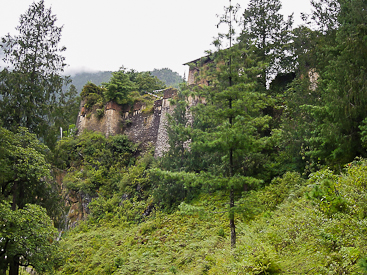
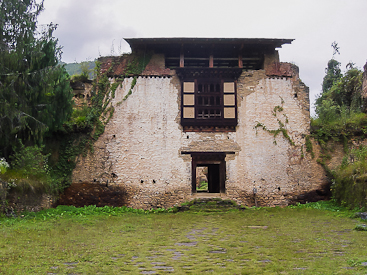
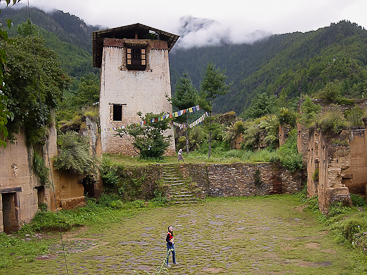
Drukyul Dzong: Our second stop was at the ruins of Drukyul Dzong. A dzong is a fortress, and there are many throughout the country. They were instrumental in repelling attacks by Tibetan and Mongol invaders. In addition to the northern invaders, the Bhutanese were also able to prevent the British from colonizing their lands, thereby remaining independent throughout their history, allowing them to retain their ancient customs and traditions. Today, dzongs are used as both monk quarters and government offices.
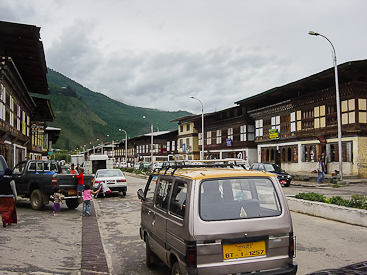
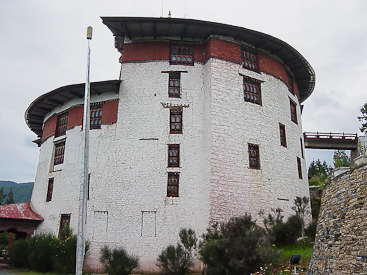
Downtown Paro: Next, we strolled the streets of downtown Paro, visiting a few shops but mostly just admiring the traditional architecture and observing people going about their daily routines. All buildings in Bhutan are constructed in traditional architecture.
Bhutan National Museum: Our final stop in Paro was at the National Museum. Historically a watchtower for the dzong below, it sits high on the slopes of one of the mountains surrounding Paro. Inside, we learned much of the culture, history and religion of the country.
With our tour of Paro complete and the road open for the evening, our driver, Pema, escorted us to the capital city of Thimpu, where we met up with our hosts for the trip. They live in a lovely three story home in the middle of Thimpu. The basement is garages and storage rooms, the first and second floors are divided into two apartments each, and the entire top floor is their living quarters. Fortunately for us, one of the apartments on the second floor was between renters, so we stayed there while in Thimpu. We met our hosts for dinner and planned the following day before retiring for the night.

